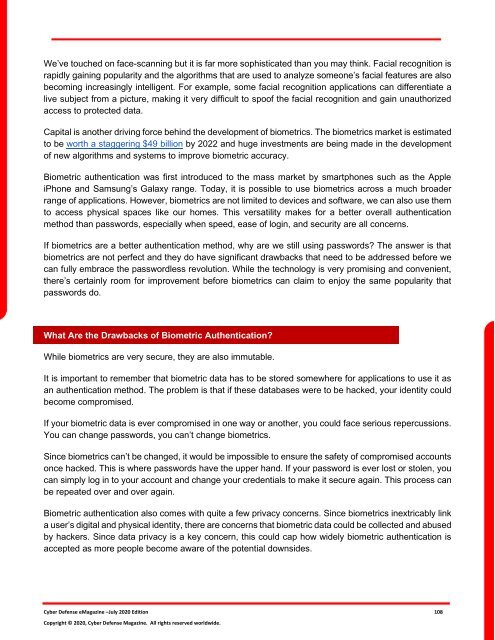Cyber Defense eMagazine July 2020 Edition
Cyber Defense eMagazine July Edition for 2020 #CDM #CYBERDEFENSEMAG @CyberDefenseMag by @Miliefsky a world-renowned cyber security expert and the Publisher of Cyber Defense Magazine as part of the Cyber Defense Media Group as well as Yan Ross, US Editor-in-Chief, Pieruligi Paganini, Co-founder & International Editor-in-Chief, Stevin Miliefsky, President and many more writers, partners and supporters who make this an awesome publication! Thank you all and to our readers! OSINT ROCKS! #CDM #CDMG #OSINT #CYBERSECURITY #INFOSEC #BEST #PRACTICES #TIPS #TECHNIQUES
Cyber Defense eMagazine July Edition for 2020 #CDM #CYBERDEFENSEMAG @CyberDefenseMag by @Miliefsky a world-renowned cyber security expert and the Publisher of Cyber Defense Magazine as part of the Cyber Defense Media Group as well as Yan Ross, US Editor-in-Chief, Pieruligi Paganini, Co-founder & International Editor-in-Chief, Stevin Miliefsky, President and many more writers, partners and supporters who make this an awesome publication! Thank you all and to our readers! OSINT ROCKS! #CDM #CDMG #OSINT #CYBERSECURITY #INFOSEC #BEST #PRACTICES #TIPS #TECHNIQUES
You also want an ePaper? Increase the reach of your titles
YUMPU automatically turns print PDFs into web optimized ePapers that Google loves.
We’ve touched on face-scanning but it is far more sophisticated than you may think. Facial recognition is<br />
rapidly gaining popularity and the algorithms that are used to analyze someone’s facial features are also<br />
becoming increasingly intelligent. For example, some facial recognition applications can differentiate a<br />
live subject from a picture, making it very difficult to spoof the facial recognition and gain unauthorized<br />
access to protected data.<br />
Capital is another driving force behind the development of biometrics. The biometrics market is estimated<br />
to be worth a staggering $49 billion by 2022 and huge investments are being made in the development<br />
of new algorithms and systems to improve biometric accuracy.<br />
Biometric authentication was first introduced to the mass market by smartphones such as the Apple<br />
iPhone and Samsung’s Galaxy range. Today, it is possible to use biometrics across a much broader<br />
range of applications. However, biometrics are not limited to devices and software, we can also use them<br />
to access physical spaces like our homes. This versatility makes for a better overall authentication<br />
method than passwords, especially when speed, ease of login, and security are all concerns.<br />
If biometrics are a better authentication method, why are we still using passwords? The answer is that<br />
biometrics are not perfect and they do have significant drawbacks that need to be addressed before we<br />
can fully embrace the passwordless revolution. While the technology is very promising and convenient,<br />
there’s certainly room for improvement before biometrics can claim to enjoy the same popularity that<br />
passwords do.<br />
What Are the Drawbacks of Biometric Authentication?<br />
While biometrics are very secure, they are also immutable.<br />
It is important to remember that biometric data has to be stored somewhere for applications to use it as<br />
an authentication method. The problem is that if these databases were to be hacked, your identity could<br />
become compromised.<br />
If your biometric data is ever compromised in one way or another, you could face serious repercussions.<br />
You can change passwords, you can’t change biometrics.<br />
Since biometrics can’t be changed, it would be impossible to ensure the safety of compromised accounts<br />
once hacked. This is where passwords have the upper hand. If your password is ever lost or stolen, you<br />
can simply log in to your account and change your credentials to make it secure again. This process can<br />
be repeated over and over again.<br />
Biometric authentication also comes with quite a few privacy concerns. Since biometrics inextricably link<br />
a user’s digital and physical identity, there are concerns that biometric data could be collected and abused<br />
by hackers. Since data privacy is a key concern, this could cap how widely biometric authentication is<br />
accepted as more people become aware of the potential downsides.<br />
<strong>Cyber</strong> <strong>Defense</strong> <strong>eMagazine</strong> –<strong>July</strong> <strong>2020</strong> <strong>Edition</strong> 108<br />
Copyright © <strong>2020</strong>, <strong>Cyber</strong> <strong>Defense</strong> Magazine. All rights reserved worldwide.


















